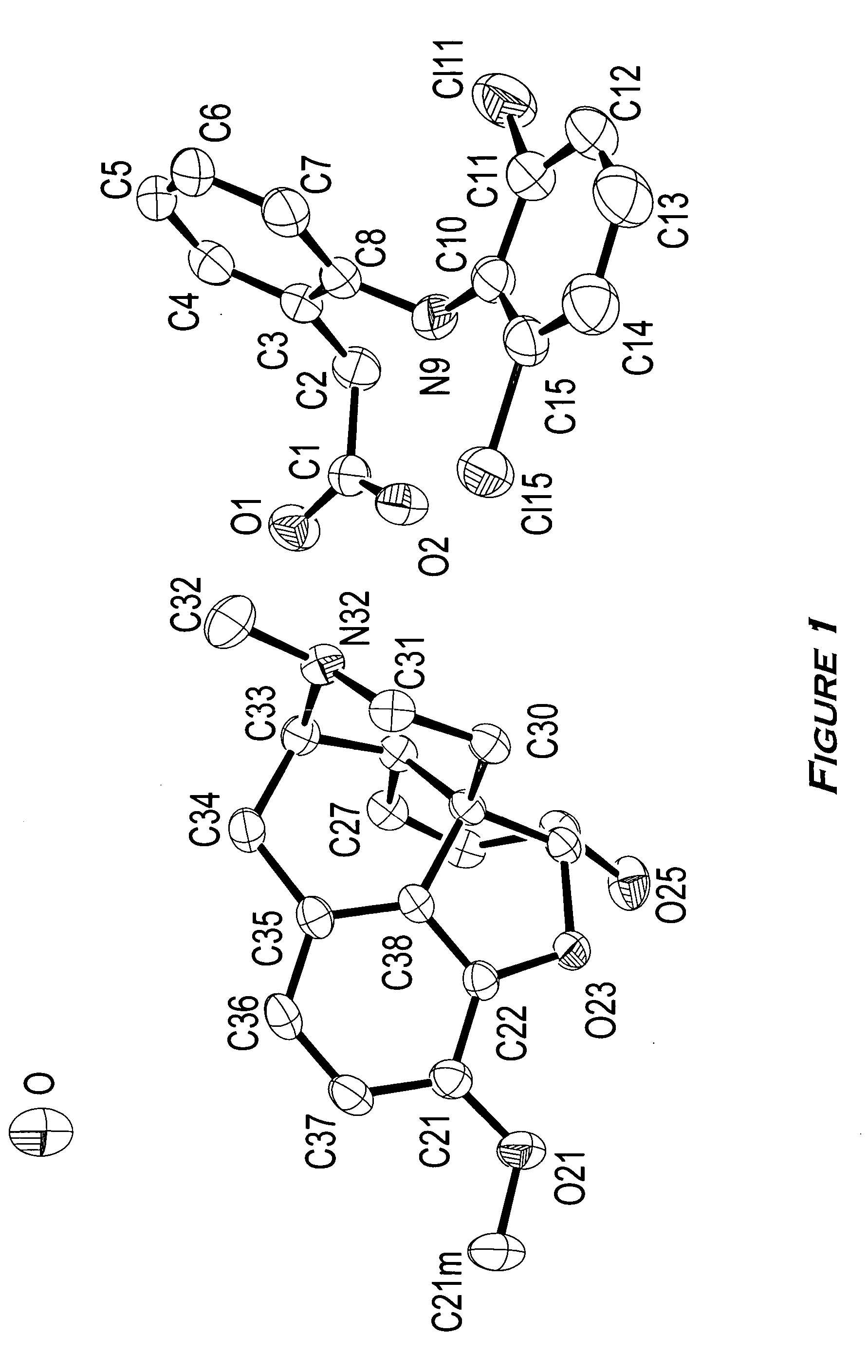Narcotic-NSAID ion pairs
a technology of narcotic and nsaid, which is applied in the field of new drug therapies, can solve the problems of strain patient compliance, enhanced therapeutic effects that cannot be achieved, and one drug may exhibit a synergistic
- Summary
- Abstract
- Description
- Claims
- Application Information
AI Technical Summary
Benefits of technology
Problems solved by technology
Method used
Image
Examples
example 1
Preparation of d-Propoxyphene Diclofenate from Sodium Diclofenac and d-Propoxyphene Napsylate Hydrate
[0073] Sodium {2-[(2,6-dichlorophenyl)amino]}phenylacetate (referred to herein as sodium diclofenac) (0.3283 g, 1.032 mmol) was dissolved in methanol (25 mL) to which was added a methanol solution (25 mL) of (2S,3R)-(+)-4-(dimethylamino)-3-methyl-1,2-diphenyl-2-butanol propionate (referred to herein as d-propoxyphene) napsylate hydrate (0.5633 g, 0.996 mmol). The two solutions were mixed well and the methanol removed over several hours by evaporation under an air purge. An oily material, which contained a white residue, was formed. Water (100 mL) was added to the oily material and solution formation enhanced by means of sonication (5 minutes). The aqueous supernatant was decanted and the residual oily material dried under reduced pressure. Methanol (25 mL) was added to dissolve the oily material, and any solid material removed by filtration through 0.45-μm polytetrafluoroethylene (P...
example 2
Preparation of d-Propoxyphene Diclofenate from Sodium Diclofenac and d-Propoxyphene Napsylate Hydrate by Ion Exchange Chromatography
[0074] d-Propoxyphene napsylate hydrate (1.8228 g, 3.222 mmol) in methanol (60 mL) was placed on a Varian MegaBond Elut strong cation exchange column (SCX), which was pre-treated with methanol. A solution of sodium diclofenac (1.0283 g, 3.232 mmol) in methanol (3 mL) was added to the column and the product eluted with excess methanol. The methanol solution was concentrated by rotary evaporation, reconstituted in dichloromethane (30 mL) with sufficient methanol to dissolve the material The solution was placed in a nitrogen cabinet for approximately 12 hours. The sample was removed from the nitrogen cabinet and the remaining solvent removed by rotary evaporation, which resulted in the formation of a white solid. The solid was dissolved in methanol and placed in the nitrogen cabinet for approximately 48 hours to remove the solvent by evaporation. The resu...
example 3
Preparation of d-Propoxyphene Diclofenate from Sodium Diclofenac and d-Propoxyphene Hydrochloride
[0075] Sodium diclofenac (0.9543 g, 3.000 mmol) in water (200 mL) was placed in a 500 mL Erlenmeyer flask. d-Propoxyphene hydrochloride (1.1219 g, 2.984 mmol) in water (200 mL) was added to the diclofenate solution resulting in the formation of a white precipitate. After mixing, the water was removed by decantation and the residual solid dissolved in an appropriate amount of diethyl ether and transferred to a 200 mL round bottom flask. The solvent was removed by rotary evaporation and the product dried under vacuum. The resulting product was a white solid.
PUM
| Property | Measurement | Unit |
|---|---|---|
| Fraction | aaaaa | aaaaa |
| Fraction | aaaaa | aaaaa |
| Dimensionless property | aaaaa | aaaaa |
Abstract
Description
Claims
Application Information
 Login to View More
Login to View More - R&D
- Intellectual Property
- Life Sciences
- Materials
- Tech Scout
- Unparalleled Data Quality
- Higher Quality Content
- 60% Fewer Hallucinations
Browse by: Latest US Patents, China's latest patents, Technical Efficacy Thesaurus, Application Domain, Technology Topic, Popular Technical Reports.
© 2025 PatSnap. All rights reserved.Legal|Privacy policy|Modern Slavery Act Transparency Statement|Sitemap|About US| Contact US: help@patsnap.com


